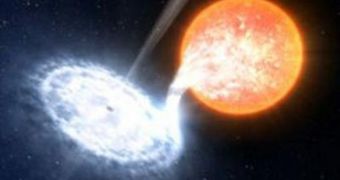In a set of investigations that could have the ability to make astronomers better understand how impressive particle jets are spewed from inside black holes, scientists have observed for the first time the hypothesized evaporation effects inside the accretion disk around such a behemoth. The observations were conducted using the Suzaku telescope, which was able to peer into the heart of a distant black hole binary system. This type of structures usually contains a star circling around a black hole, and emits vast amounts of radiation. It is most active in X-rays, astrophysicists say.
The goal of the investigation was also to determine how the binary systems produced the blast jets of gases that emanated from them at roughly 30 percent of the speed of light. Up to this point, the experts have determined that the star orbiting the black hole is essentially being stripped of its outer layers of matter, which are drawn by the vortex of its neighbor. The matter gathers in the accretion disk, from where it is periodically radiated as the powerful jets. The strong magnetic fields around the black holes also contribute to creating the high-energy photons that are then emitted as radiation.
“When a lot of gas is flowing, the dense disk reaches nearly to the black hole. But when the flow is reduced, theory predicts that gas close to the black hole heats up, resulting in evaporation of the innermost part of the disk,” University of California in Berkeley (UCB) scientist John Tomsick, who has been a part of the new research, explains. The UCB group says that this is the first unambiguous signature of this type of transformations ever recorded.
“We see emission only from the densest gas, where lots of iron atoms are producing X-rays, but that emission stops close to the black hole – the dense disk is gone. What's really happening is that, at low accretion rates, the dense inner disk thins into a tenuous but even hotter gas, rather like water turning to Steam,” University of Iowa expert Philip Kaaret says. The team adds that, on average, the accretion disk can reach temperatures in excess of 20 million degrees Fahrenheit, but that the temperature of the evaporated part of the disk can reach thousands of times that level.
“This doesn't tell us how jets form, but it does tell us that jets can be launched even when the high-density accretion flow is far from the black hole. This means that the low-density accretion flow is the most essential ingredient for the formation of a steady jet in a black hole system,” Tomsick concludes.

 14 DAY TRIAL //
14 DAY TRIAL //